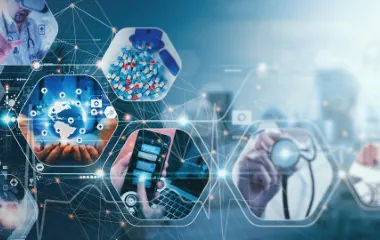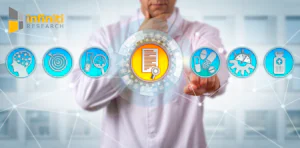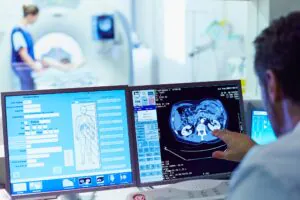The medical devices industry is experiencing a revolutionary transformation driven by technological advancements and automation. Key trends which are at the forefront of this change: Artificial intelligence (AI), Machine Learning, IoT and Connected Devices, Robotics, 3D Printing, Augmented and Virtual Reality, Nanotechnology, Automation in Manufacturing, and Blockchain. These innovations are reshaping healthcare delivery, improving patient outcomes, and streamlining medical processes. From AI-assisted diagnostics and AI-powered analytics and forecasting to 3D-printed implants, and from robotic surgeries to blockchain-secured medical records, these technologies are pushing the boundaries of what’s possible in medicine.
As the lines between traditional medical devices, digital health, and biotechnology blur, the industry faces both unprecedented opportunities and new challenges in areas such as data privacy, regulatory compliance, and ethical considerations. Understanding these trends is crucial for healthcare providers, technology companies, and policymakers as they navigate the future of healthcare, while also considering ESG (Environmental, social and governance) factors.
What’s the need of MedTech and Automation?

The need for these advanced applications in medical devices stems from several critical challenges facing the healthcare industry. Rising healthcare costs, physician shortages, and an aging population with increasing chronic disease burdens necessitate more efficient, accurate, and accessible healthcare solutions. There’s a growing demand for personalized medicine, minimally invasive procedures, and continuous health monitoring. Additionally, the complexity of medical data, the need for improved patient engagement, and concerns about data security and privacy drive the adoption of these technologies. The healthcare sector also faces pressures to reduce human error, enhance training methods, and streamline manufacturing and supply chain processes. Developers, creators, and manufacturers are increasingly focused on patient safety and physician autonomy.
Transform your MedTech strategy with our expertise—connect with Infiniti Research to leverage cutting-edge insights, innovative solutions, and industry-leading strategies designed to revolutionize healthcare delivery and drive growth today…
MedTech and Automation Trends
Key Medical Device Trends
- AI and Machine Learning (ML) Application
- IoT and Connected Devices Applications
- Robotics Applications
- 3D Printing Applications
- Augmented and Virtual Reality Applications
- Nanotechnology Applications
- Automation in Manufacturing Applications
- Blockchain Applications
1. AI and Machine Learning (ML) Application
Enlisted below are some of the key applications of AI and ML in medical devices sector:
- Diagnostic support: AI analyzes medical images, lab results, and patient data to assist in disease detection and diagnosis.
- Treatment planning: AI systems suggest personalized treatment plans based on patient data and medical research.
- Drug discovery: Machine learning accelerates drug development by predicting molecular interactions and potential side effects.
- Predictive analytics: AI models forecast patient outcomes, disease progression, and hospital resource needs.
- AI dashboards: Providing real-time insights and decision support for healthcare providers.
AI and Machine Learning Landmark example: IBM Watson for Oncology IBM Watson analyzes a patient’s medical information against a vast database of medical literature to suggest personalized cancer treatment options. It’s been implemented in hospitals worldwide, including Memorial Sloan Kettering Cancer Center in New York. However, developers must be aware of potential bias in datasets used to train these AI systems.
2. IoT and Connected Devices Applications
Enlisted below are some of the key applications of IoT and Connected Devices in medical devices sector:
- Remote patient monitoring: Wearable devices track vital signs and alert healthcare providers to potential issues.
- Medication adherence: Smart pill bottles remind patients to take medication and track usage.
- Hospital asset tracking: IoT sensors monitor the location and status of medical equipment.
- Environmental monitoring: Connected devices ensure optimal conditions in healthcare facilities, labs, and drug storage areas.
- Data analysis tools: Extracting insights from the vast amount of data generated by connected devices.
IoT and Connected Devices Landmark example: Dexcom G6 Continuous Glucose Monitoring System This device continuously monitors blood glucose levels in diabetic patients and sends real-time data to smartphones and other devices. It can alert users and their healthcare providers to dangerous blood sugar levels.
3. Robotics Applications
Enlisted below are some of the key applications of Robotics in medical devices sector:
- Minimally invasive surgery: Robotic systems enable precise surgical procedures with smaller incisions.
- Rehabilitation: Robotic exoskeletons assist in physical therapy and mobility for patients with disabilities.
- Hospital logistics: Autonomous robots deliver supplies, medications, and meals within healthcare facilities.
- Telepresence: Robotic systems allow remote consultations and examinations.
- Collaborative robots (cobots): Working alongside human staff to enhance efficiency and safety.
Robotics Landmark example: da Vinci Surgical System by Intuitive Surgical – this robotic surgical system allows surgeons to perform complex procedures with enhanced precision, flexibility, and control. It’s widely used for minimally invasive surgeries across various specialties.
4. 3D Printing Applications
Enlisted below are some of the key applications of 3D Printing in medical devices sector:
- Custom prosthetics and implants: Patient-specific devices are created for better fit and functionality.
- Surgical planning: 3D printed models of patient anatomy aid in preoperative planning.
- Bioprinting: Tissue and organ structures are created for research and potential transplantation.
- Medical equipment: On-demand printing of tools and parts, especially useful in remote areas.
- Component level: 3D printing of complex components for medical devices.
3D Printing Landmark example: Organovo’s 3D Bioprinted Liver Tissue Organovo has successfully bioprinted liver tissue for drug testing and disease modeling. This technology could potentially lead to printing functional organs for transplantation in the future.
5. Augmented and Virtual Reality Applications
Enlisted below are some of the key applications of Augmented and Virtual Reality in medical devices sector:
- Medical training: Realistic simulations for surgical practice and anatomy education.
- Patient education: Interactive 3D models explain conditions and treatments to patients.
- Surgical navigation: AR overlays provide real-time guidance during procedures.
- Therapy: VR environments assist in pain management, phobia treatment, and PTSD therapy.
Augmented and Virtual Reality Landmark example: Osso VR This VR surgical training platform allows surgeons to practice complex procedures in a virtual environment. It’s been adopted by several medical schools and hospitals for training purposes.
6. Nanotechnology Applications
Enlisted below are some of the key applications of Nanotechnology in medical devices sector:
- Targeted drug delivery: Nanoparticles carry medications directly to specific cells or organs.
- Diagnostics: Nano-scale sensors detect diseases at the molecular level.
- Tissue engineering: Nanostructures support the growth of new tissues for regenerative medicine.
- Antimicrobial surfaces: Nanocoatings on medical devices reduce infection risks.
- Genomics and molecular diagnostics: Nanotechnology enabling advanced genetic testing and analysis.
Nanotechnology Landmark example: Nanoparticle-based Cancer Treatment Researchers at MIT developed nanoparticles that can carry three cancer drugs simultaneously, allowing for more targeted and effective treatment of multiple-drug-resistant cancers.
7. Automation in Manufacturing Applications
Enlisted below are some of the key applications of
Automation in manufacturing within medical devices sector:
- Quality control: Automated systems ensure consistency and detect defects in medical device production.
- Clean room operations: Robots perform tasks in sterile environments, reducing contamination risks.
- Packaging and sterilization: Automated systems handle delicate components and maintain sterility.
- Supply chain management: AI-driven systems optimize inventory and production scheduling.
- Packaging solutions and trends: Innovative, automated packaging processes for medical devices.
Automation in Manufacturing Landmark example: Siemens Healthineers’ Automated Production Lines Siemens has implemented highly automated production lines for manufacturing medical imaging equipment, improving efficiency and quality control in their factories.
8. Blockchain Applications
Enlisted below are some of the key applications of Blockchain in medical devices sector:
- Medical records: Secure, decentralized storage of patient data ensures privacy and accessibility.
- Clinical trials: Blockchain improves data integrity and participant consent management.
- Counterfeit prevention: Tracking systems verify the authenticity of pharmaceuticals and medical devices.
- Claims processing: Streamlined, transparent systems for healthcare billing and insurance claims.
Blockchain Landmark example: MediLedger This blockchain-based network, developed by Chronicled, is used by major pharmaceutical companies to track and verify prescription medicines, enhancing supply chain security and reducing counterfeit drugs.
These applications demonstrate how each trend is transforming various aspects of healthcare, from patient care and medical research to manufacturing and administration. The impact of these applications is transformative across the healthcare landscape. They collectively improve diagnostic accuracy, treatment effectiveness, and patient outcomes while often reducing costs and increasing accessibility. AI and IoT devices enable more personalized and proactive care, while robotics and 3D printing revolutionize surgical procedures and medical device production. AR/VR and nanotechnology open new frontiers in medical training and targeted therapies. Automation in manufacturing ensures higher quality and consistency in medical devices, and blockchain technology enhances data security and supply chain transparency.
Future-proof your business in the dynamic MedTech landscape by collaborating with us—unlock the power of tailored innovation, data-driven solutions, and expert guidance to stay ahead of the curve and achieve long-term success…
Ending Thoughts
Overall, these innovations are shifting healthcare towards a more precise, patient-centric, and data-driven model, although their implementation also brings challenges related to regulation, ethics, and systemic integration. The industry is also seeing trends towards multi-sourcing, reshoring and nearshoring of production, and an increased focus on single-source medical device manufacturers. Life science instrument development continues to advance, particularly in areas like genomics and molecular diagnostics.



